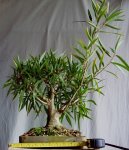Anthony
Imperial Masterpiece
So today, we found a colander that is just over 24 " by 6" deep. plastic and had a chuckle about
double / triple colanders.
This led to a re-reading of Bonsai Today no.20 page 47.
The diagram at the bottom left of page shows, roots, thick ones in the first colander, and
becoming finer in the second.
Perhaps the idea was to get the roots around the tree to enlarge for the root flare and the
second was to continue the root sub-division, and to thicken the roots going toe the trunk.
Just was not in the translation.
So we will look for this in the Caribbean Pine container, let you know how it goes.
Good Day
Anthony
double / triple colanders.
This led to a re-reading of Bonsai Today no.20 page 47.
The diagram at the bottom left of page shows, roots, thick ones in the first colander, and
becoming finer in the second.
Perhaps the idea was to get the roots around the tree to enlarge for the root flare and the
second was to continue the root sub-division, and to thicken the roots going toe the trunk.
Just was not in the translation.
So we will look for this in the Caribbean Pine container, let you know how it goes.
Good Day
Anthony




